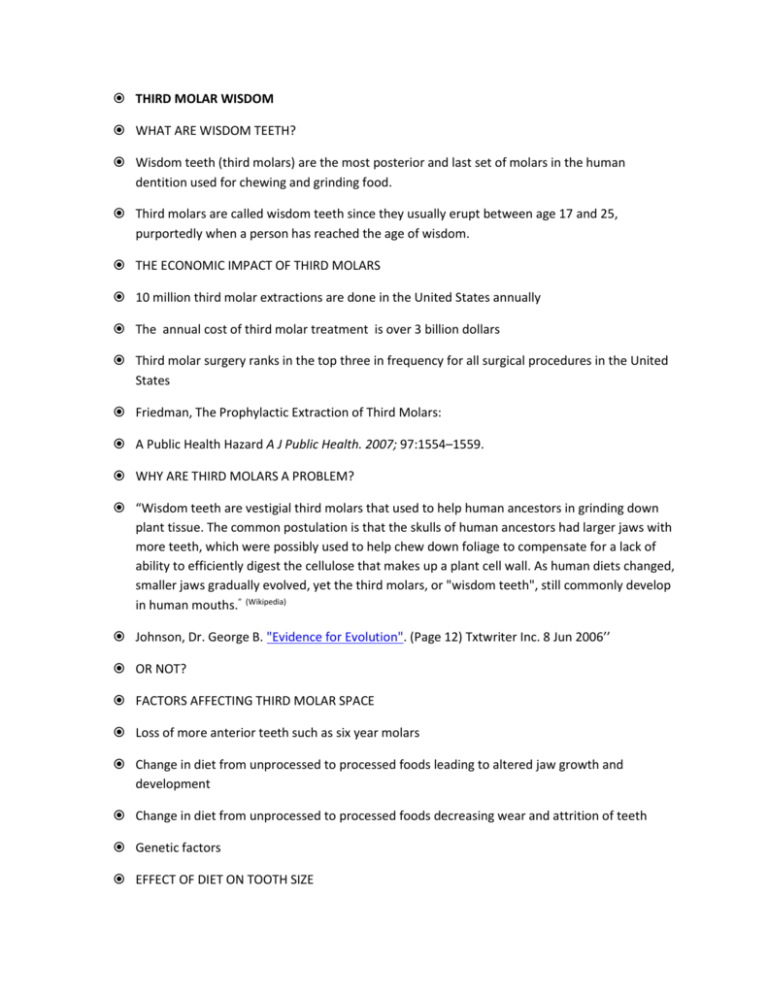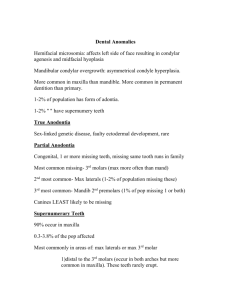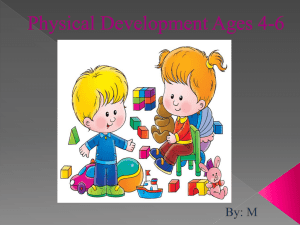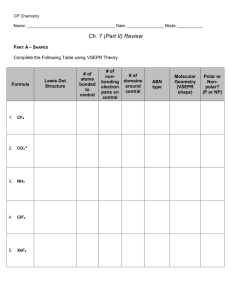Lecture Outline - Global Missions Health Conference
advertisement

THIRD MOLAR WISDOM WHAT ARE WISDOM TEETH? Wisdom teeth (third molars) are the most posterior and last set of molars in the human dentition used for chewing and grinding food. Third molars are called wisdom teeth since they usually erupt between age 17 and 25, purportedly when a person has reached the age of wisdom. THE ECONOMIC IMPACT OF THIRD MOLARS 10 million third molar extractions are done in the United States annually The annual cost of third molar treatment is over 3 billion dollars Third molar surgery ranks in the top three in frequency for all surgical procedures in the United States Friedman, The Prophylactic Extraction of Third Molars: A Public Health Hazard A J Public Health. 2007; 97:1554–1559. WHY ARE THIRD MOLARS A PROBLEM? “Wisdom teeth are vestigial third molars that used to help human ancestors in grinding down plant tissue. The common postulation is that the skulls of human ancestors had larger jaws with more teeth, which were possibly used to help chew down foliage to compensate for a lack of ability to efficiently digest the cellulose that makes up a plant cell wall. As human diets changed, smaller jaws gradually evolved, yet the third molars, or "wisdom teeth", still commonly develop in human mouths.” (Wikipedia) Johnson, Dr. George B. "Evidence for Evolution". (Page 12) Txtwriter Inc. 8 Jun 2006’’ OR NOT? FACTORS AFFECTING THIRD MOLAR SPACE Loss of more anterior teeth such as six year molars Change in diet from unprocessed to processed foods leading to altered jaw growth and development Change in diet from unprocessed to processed foods decreasing wear and attrition of teeth Genetic factors EFFECT OF DIET ON TOOTH SIZE Populations subsisting on unprocessed coarse diets had significantly more wear of their dentition resulting in shorter narrower teeth and increased third molar space. Townsend, G. and Brown, T., 1983. Molar size sequence in Australian Aboriginals. American Journal of Physical Anthropology, 60:69–74. Goose, D.H., 1963. Dental measurement: an assessment of its value in anthropological studies. In: Dental Anthropology, D.R. Brothwell (ed.), Pergamon Press Oxford, UK, p. 179–190. EFFECT OF DIET ON JAW SIZE AND MORPHOLOGY Populations that consume a soft refined agricultural diet tend to have shorter, broader jaws than those who consume a hunter-gatherer diet exhibit longer, narrower jaws. The later group has significantly more space for third molars. Noreen von Cramon-Taubadel, “Global Human Mandibular Variation Reflects Difference in Agricultural and Hunter-Gatherer Subsistence Strategies,” Proceedings of the National Academy of Sciences, USA 108 (2011): 19546–51. THIRD MOLAR DEVELOPMENT INITIAL CALCIFICATIONS AGE 7-9 INITIAL CALCIFICATION CROWN MINERALIZATION AGE 12-14 CROWN MINERALIZATION ROOT FORMATION HALF COMPLETE AGE 16 ROOT FORMATION ROOT FORMATION AGE 18 ROOT FORMATION AGE 18 THIRD MOLAR ERUPTION Approximately one third of the population will have one or more impacted third molars with a 25% incidence overall and a higher incidence in the lower jaw Majority of teeth that will erupt do so in the early 20s with 95% erupting by age 24 Eruption later in life is possible but less likely. Schersten E. Prevalence of impacted third molars in dental students. Swed Dent J 1989; 13(12):7-13 THIRD MOLAR PATHOLOGY Pericoronitis Caries Periodontitis Abscess/infection Cysts and Tumors Miscellaneous concerns PERICORONITIS PERICORONITIS Acute inflammation and swelling of gum tissue over and around a partially erupted tooth (the operculum) caused by infection by bacteria. The most common reason for therapeutic third molar removal. Can be mild to severe. PERICORONITIS SYMPTOMS Pain Swelling Trismus (difficulty opening) Malodor Purulence/drainage Inability to close teeth together due to trauma to the swollen operculum PERICORONITIS PERICORONITIS TREATMENT Local debridement/irrigation/oral hygiene with soft toothbrush, antimicrobial mouth washes, and hot salt water soaks for mild cases. More severe cases (swelling, fever, severe pain) require systemic antibiotics (amoxicillin or clindamycin) and close observation and more aggressive treatment if infection increases and spreads. PERICORONITIS TREATMENT Definitive treatment is to remove the involved tooth. Timing of extraction is controversial and varies with the severity of the infection. Operculectomy in limited resource situations may be best temporary option. OPERCULECTOMY CARIES THIRD MOLAR CARIES Posterior position and limited room decrease effective oral hygiene. Partially exposed impacted teeth cause particular difficulty in hygiene frequently affecting the second molars as well 77% of subjects of a recent study of 6,550 adults aged 52 to 74 had experienced caries on at least one of their visible third molars. Fisher EL 2010 Third molar caries experience in middle-aged and older Americans: a prevalence study. J Oral Maxillofac Surg 2010 Mar;68(3):634-40 THIRD MOLAR CARIES SECOND AND THIRD MOLAR CARIES SECOND AND THIRD MOLAR CARIES THIRD MOLAR CARIES TREATMENT Decayed third molars should usually be extracted and the second molar restored if possible. In limited resource settings, if the second molar is involved, both the second and third molars should be removed. PERIODONTITIS PERIODONTITIS Due to access problems and thinner mucosal tissue, even fully erupted third molars have proven to be more susceptible to periodontitis. With partially exposed impacted teeth with periodontal bone loss, the second molars are usually involved early on. PERIODONTITIS The role of pathogenic bacteria in the periodontal biofilm in progressive periodontitis spreading to adjacent teeth has recently been well characterized. Periodontal disease of adjacent teeth where there are visible third molars is progressive and only partially responsive to treatment. Pocket depths of greater than 4-5 mm and/or bleeding on probing should be recognized as signs and predictors of future progression of periodontitis. PERIODONTITIS Studies of the microflora of asymptomatic disease in the third molar region show: Absence of symptoms does not indicate absence of disease. Pathogenic bacteria exist in clinically significant numbers around asymptomatic third molars Indicators of chronic inflammation exist in periodontal pockets in and around asymptomatic third molars White RP, Synopsis and discussion of data from 3rd molar clinical trials. AAOMS 93rd Scientific Meeting 9/17/11 PERIODONTITIS Periodontitis is associated with increased risk of developing atherosclerosis; this association is independent and cannot be attributed to shared risk factors. The effect of periodontal therapy on future atherosclerotic disease related clinical events has not yet been adequately studied. Papanou PN. Periodontitis and atherosclerotic vascular disease: What we know and why it is important. JADA 2012;143(8):826-828 PERIODONTITIS Research evidence suggests that maternal gingivitis and periodontitis may be a risk factor for preterm birth and adverse pregnancy outcomes. Periodontal infection can lead to placental-fetal exposure and fetal inflammatory response leading to preterm delivery . PERIODONTITIS Recent studies have shown that active treatment of periodontal disease during pregnancy did not improve outcomes due to ineffectiveness of routine treatment in controlling disease progression. Garvin J. Perio treatment, preterm delivery unrelated study shows. ADA News 2/9/2009 PERIODONTITIS PERIODONTITIS TREATMENT Brushing and flossing Scaling and root planing Surgical pocket elimination Antibiotics THIRD MOLAR INFECTION THIRD MOLAR INFECTION Can result from caries or periodontal disease including pericoronitis. Cellulitis Abscess Abscess spread along fascial planes to adjacent spaces THIRD MOLAR INFECTION TREATMENT Incision and drainage Systemic antibiotics Treatment of source of the infection Supportive care CYSTS AND TUMORS CYSTS Preventable by early removal of tooth and follicle. The follicle or pericoronal tissue is the source of most third molar associated pathology. When do we submit follicular tissue for biopsy? DENTIGEROUS CYST (FOLLICULAR CYST) DENTIGEROUS CYST KERATOCYSTIC ODONTOGENIC TUMOR CYST TREATMENT Aspirate first to rule out vascular lesions Consider decompression/marsupialization if benign diagnosis Complete excision with concern for possible mandibular fracture Long term follow up NOT ALL RADIOLUCENCIES ARE CYSTS Tumors Lymphoma Multiple myeloma Metastatic Carcinoma TUMORS Benign vs. malignant Odontogenic vs. non-odontogenic Primary vs. secondary Treatment dependant on the diagnosis AMELOBLASTOMA OSTEOSARCOMA MISCELLANEOUS PROBLEMS: RESORPTION MISCELLANEOUS PROBLEMS: SUPRAERUPTION MISCELLANEOUS PROBLEMS: FRACTURE SHOULD THIRD MOLARS BE REMOVED AND IF SO, WHEN? CONSENSUS Symptomatic third molars with associated pathology should be removed. Asymptomatic third molars with significant pathology should be removed. CONTROVERSY Is “prophylactic” removal ever indicated? Are fully erupted third molars beneficial? Do the surgical costs and risks justify removing third molars at the optimum time? When is the optimum time? EVALUATION OF RISK/BENEFIT CONSIDERATIONS There are costs and surgical risks involved in third molar removal. Improved technology (CBCT, hand pieces) and techniques (coronectomy) have decreased the risks and increased the predictability of treatment. Third molars provide little functional benefit and with the advent of implants are a third line treatment option for missing second molars (transplantation or fixed prosthesis.) CONSIDERATIONS The cost of lifelong monitoring of impacted third molars is significant. There are local and systemic implications of third molar retention. Complication rates and surgical morbidity and difficulty increase over time. THIRD MOLAR TIMING Age 7-11: Tooth germs first visible superficial and close to alveolar crest in mandible. AGE 7-11 MANDIBULAR Removal requires minimal bone removal in mandible. Patient maturity and parental support are highly variable AGE 7-11 MANDIBULAR Removal at this age is controversial, not many studies of early intervention in the literature. Questions revolved around whether tooth would eventually have space to erupt which is probably no longer a valid concern. GERMECTOMY Half as much post operative pain medication is necessary. One third quicker procedure. Well tolerated under local anesthesia in compliant patients. Bjornland T. Removal of third molar germs: study of complications. Int J Oral Maxillofacial Surg 1987;16:385-390 AGE 7-11 MAXILLARY Tend to be high in the maxilla. Small size makes location difficult. Increased risk to developing second molars due to size and location. Increased operating time and frustration. Increased post operative pain and swelling AGE 7-11 SUMMARY Lower third molars are usually simple and uppers very difficult and pose a risk to second molars. As patients age 90% of the morbidity is from removal of lower third molars. Less anesthetic requirements but variable patient management issues. AGE 12-14 Progressive crown mineralization. Lower thirds descend from ridge crest increasing difficulty. Upper thirds still with limited accessibility. Patients may still have maturity issues at this age. AGE 15-18 Root formation has begun and is progressing to completion. Patient more psychologically accepting of surgery at this age. Research confirms that complication rates are lowest in this age range. AGE 15-18 The follicular space allows for relatively easy removal after access. There is no PDL (attachment of tooth to bone.) The deep follicle of the forming roots acts as a safety zone between the tooth and the IAN. The tooth may spin and hard to stabilize for surgical sectioning and removal. AGE 19-22 Root development is not always complete making removal still favorable at this age. AGE 22-35 Nearly all patients at this age have fully developed third molars losing most of the advantages of early removal. The alveolar bone maintains good elasticity usually simplifying removal and improving healing as compared to later removal. Patient population is generally healthy. AGE 35-45 Most patients are still ASA I or II Mineral content of bone is increased delaying healing and increasing difficulty and morbidity. OVER AGE 45 Highest complication rates including infection, bone loss, and fracture. Increased incidence and poorest recovery of nerve injury. Increased discomfort and swelling and prolonged healing. Health may be compromised with many co morbidities. TIMING SUMMARY Treatment in the mid to late second decade decreases surgical risk, morbidity, and difficulty in a patient population that will recover more rapidly and are in generally good health.







